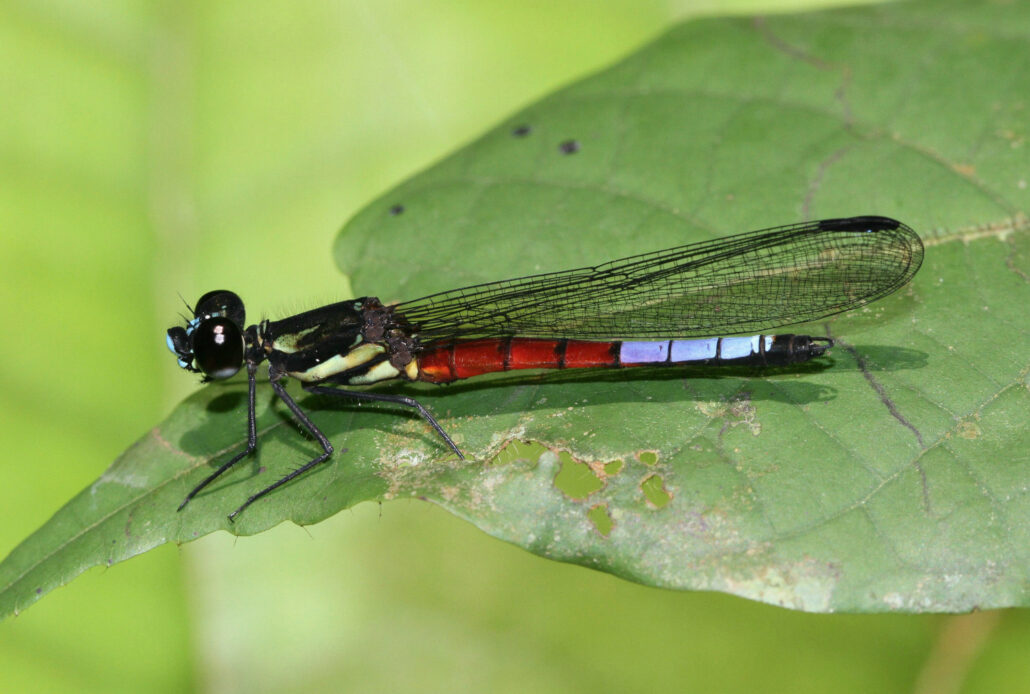
With the most recent update of the IUCN Redlist1 as of 9th December 2021, the number of species at risk of extinction on the Red List has exceeded 40,000 for the first time. The IUCN Red List now includes 142,577 species of which 40,084 are threatened with extinction. However, of the largest of all organism groups, the insects, only 12,100 species are assessed so far. The complete dragonfly assessment contributes almost 50% to this number (6,016 species). The assessment was done by IUCN SSC Dragonfly Specialist Group co-chaired by Viola Clausnitzer and Federico Lozano.
“Dragonflies are highly sensitive indicators of the state of freshwater ecosystems, and this first global assessment finally reveals the scale of their decline. It also provides an essential baseline we can use to measure the impact of conservation efforts,” said Dr Clausnitzer, “To conserve these beautiful insects, it is critical that governments, agriculture and industry consider the protection of wetland ecosystems in development projects, for example by protecting key habitats and dedicating space to urban wetlands.”
The assessment of the world’s dragonflies and damselflies reveals that 16% out of 6,016 species are at risk of extinction (categories CR, EN, VU and NT combined); 11% are threatened if counting only the three IUCN threat categories (CR, EN and VU). The destruction of wetlands is driving the decline of dragonflies worldwide. Their decline is symptomatic of the widespread loss of the marshes, swamps and free-flowing rivers they breed in, mostly driven by the expansion of unsustainable agriculture and urbanization (for instance in South America) around the world. In South and Southeast Asia, more than a quarter of all species are threatened, mostly due to the clearing of wetland and rainforest areas to make room for crops such as palm oil. In Central and South America, the major cause of dragonflies’ decline is the clearing of forests for residential and commercial construction. Pesticides, other pollutants (particularly eutrophication) and climate change are growing threats to species in every region of the world, and are the greatest threats to dragonflies s in North America and Europe. However, it was recently demonstrated that many riverine species in Central Europe recovered after heavy declines, which is due to various programs aiming to increase water quality and restore natural river morphology2, indicating that restoration efforts are not futile.
Dr Jon Paul Rodríguez, Chair of the IUCN Species Survival Commission pointed out that “Most of Earth’s surface, about 71%, is covered by oceans. But only 3.5% of Earth’s water is freshwater. Humans share this precious resource with all other organisms that live on land. The decline of dragonflies brings again to our attention the need to prioritise investment in freshwater ecosystems, an issue that is often overlooked. For example, SDG 14 in English is “Life Below Water,” while in Spanish it is “Vida Submarina” (Submarine Life), completely ignoring continental waters“.
Dr Bruno Oberle, IUCN Director General added: “By revealing the global loss of dragonflies, today’s Red List update underscores the urgent need to protect the world’s wetlands and the rich tapestry of life they harbour. Globally, these ecosystems are disappearing three times faster than forests. Marshes and other wetlands may seem unproductive and inhospitable to humans, but in fact they provide us with essential services. They store carbon, give us clean water and food, protect us from floods, as well as offer habitats for one in ten of the world’s known species.”
The assessment has been supported by Toyota Motor Corporation.
WDA congratulates the members of IUCN SSC Dragonfly Specialist Group, several of them being WDA members, in successfully finishing this great task.
Read the full press release via IUCN.
1 www.iucnredlist.org
2 Bowler et al. (2021) Diversity and Distributions, doi: 10.1111/ddi.13274
